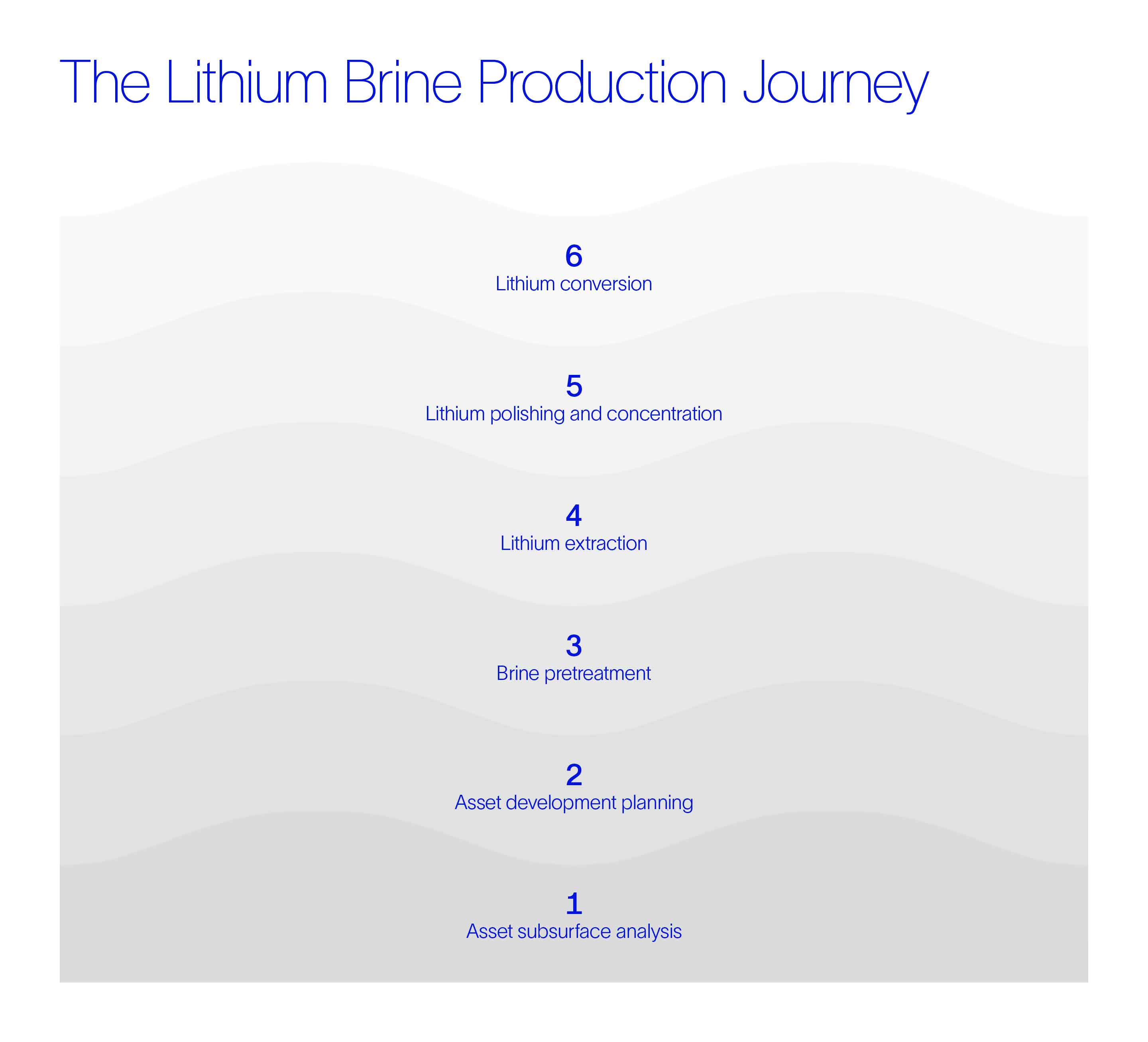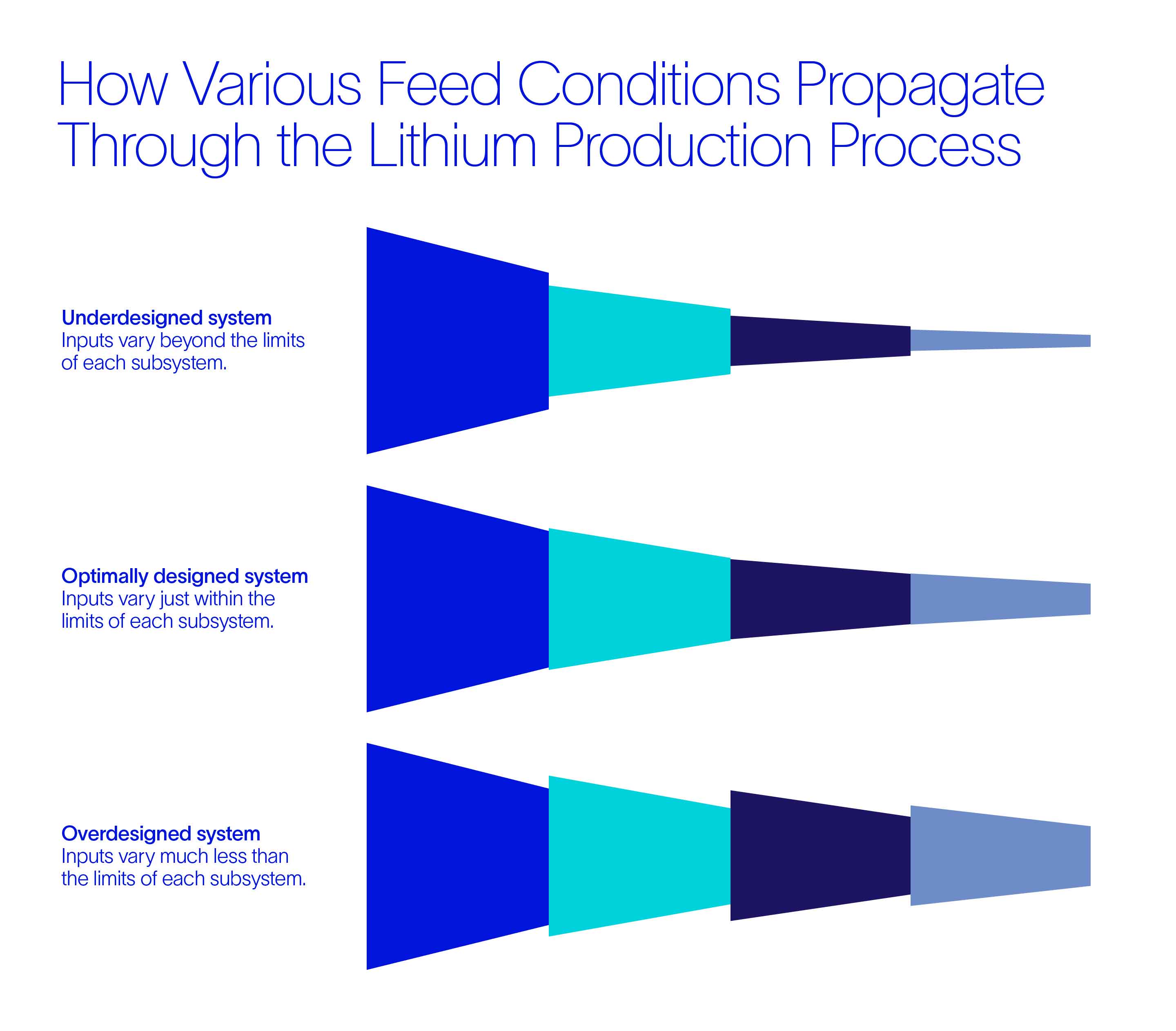In this article
- The journey of lithium brine production, from asset subsurface analysis to lithium conversion.
- The importance of using digital solutions to optimally integrate subsystems and manage feedstock variability.
- How digital enablement improves well-to-product integration, including more efficient direct lithium extraction compared to current evaporation ponds.
- Designing facilities with sustainability as a core principle by minimizing energy, water, and reagent consumption.
- How digital solutions contribute to future optimization by enhancing plant performance optimization and equipment reliability in lithium extraction facilities.
Lithium production stands at the forefront of the global transition toward renewable energy. This critical mineral powers everything from smartphones to electric cars. Driven by the demand for electric vehicles and energy storage systems, lithium production is projected to increase 4 to 5 times between 2024 and 2030. However, the journey of brine from well to product (i.e., from extracting raw lithium brine from subsurface aquifers to its transformation into a market-ready product) is a complex process that requires subsurface analysis, chemical processes, and advanced engineering systems.
The good news is that today’s digital solutions streamline and optimize every stage of this process—from planning and production to maintenance and operations—by helping operators manage variability and ensure optimal, cost-effective operations.
The journey of lithium brine production
The lithium production process consists of several critical phases, each requiring meticulous planning and execution:
- Asset subsurface analysis: Understanding geological formations and lithium brine quality and concentrations is essential. Detailed subsurface analysis helps identify the most promising lithium-rich zones. This ensures efficient and effective drilling and well completion that, in turn, ensures optimal flows and consistent brine for your operations.
- Asset development planning: Efficiently accessing lithium brine reservoirs requires advanced drilling techniques. Expertise in drilling tech, developed and improved through years in the oil and gas industry, enables you to tap into lithium resources with precision and minimize your environmental impact.
- Brine pretreatment: This is the initial treatment of raw brine that conditions it for lithium extraction. Pretreatment steps may include filtration and chemical adjustments to remove certain impurities that could hurt the extraction resin or membranes.
- Lithium extraction: This core process involves separating lithium ions from other constituents using adsorption-based direct lithium extraction (DLE). It's a method known for offering high selectivity and efficiency.
- Lithium polishing and concentration: Refining the extracted lithium to achieve desired purity and concentration ensures that the final product meets industry standards.
- Lithium conversion: These final steps chemically convert lithium concentrate into a market-ready product, such as lithium carbonate or lithium hydroxide, both of which are used in battery manufacturing.

Using digital solutions to optimally integrate your subsystems
Achieving seamless operations in lithium production requires carefully managing subsystems and their interdependencies. Variability in feed conditions can propagate throughout the process, making it difficult to maintain optimal performance. This is where digital solutions play another critical role by enabling more informed decision making throughout a plant’s life cycle.

A deep understanding of subsurface conditions, well networks, production and processing pipelines, and production facilities allows equipment designers to develop robust systems that maintain optimal plant performance throughout the asset's life. Advanced multiphysics models predict how factors such as temperature, pressure, and chemical reactions interact with one another. This understanding helps designers reduce feedstock variability, avoid equipment oversizing, and maintain smooth plant operation within target operating ranges. It also identifies potential disruptions before they occur, which helps ensure consistent production throughput and minimized downtime.
Since inlet stream compositions can vary significantly over time, initial plant design must account for these fluctuations. For instance, variations in silica levels can push equipment to its operational limits, potentially causing equipment damage and plant disruptions. Initial design bases for plants are often developed using early well samples, but the actual composition of the brine can change significantly over time. This requires ongoing adjustments—another reason why combining a robust design with flexible operational strategies is important.
Digital solutions allow for strategies that adapt to changing conditions, thereby optimizing facility performance while reducing capital and operational expenses. By tailoring the well-field design to the specific characteristics of the resource, you can achieve a balanced, efficient, and cost-effective extraction process.
An example of what’s possible given today’s tech
Integrating the production of lithium from well all the way to product (including the use of DLE-based systems) offers significant advantages over conventional evaporation ponds by improving efficiency in terms of yield, processing time, and reduced environmental impact. That said, it's an approach that requires accurate and dynamic control of all aspects of a facility to meet the stringent purity required for battery material.
Instrumentation and advanced chemical sampling systems provide real-time process insights, allowing for the precise adjustment of operating parameters to produce a high-quality product. Automated sampling systems, equipped with lab workflows and proxy sensors enabled by the Internet of Things (IoT), facilitate real-time decision making and integrity throughout the production process.
Sustainability at the forefront of lithium production
Minimizing the environmental footprint of lithium production facilities is a foundational design principle and critical for successfully reducing a plant's power consumption, freshwater usage, waste streams, and reagent consumption.
To achieve your sustainability objectives, the system design must recycle process streams to harvest water, heat, and reagents. High-fidelity thermodynamic models, for example, can predict how heat, energy, and materials move and interact within the plant, thus allowing plant design to operate more efficiently and reduce unnecessary waste. This is further enhanced by what-if and trade-off analytics that further optimize operational parameters.
Processing high-salinity brines to extract high-purity lithium compounds comes with its own unique challenges; challenges that can also be addressed by advanced control systems. For instance, precisely controlling chemical reactions is essential for the targeted manipulation of brine composition. Unexpected changes can disrupt the system, requiring time to correct and potentially leading to nonconforming streams. If the system does not react swiftly enough, these issues can demand reprocessing to prevent equipment fouling and ensure product quality.
Digital solutions help track and improve sustainability beyond the operational aspects of the extraction process by reducing energy consumption through the recycling and reutilization of heat waste streams. A similar approach can be applied to minimize chemical and water usage, especially for facilities located in remote desert locations (e.g., Chile and Argentina). Such use of digital solutions not only lowers operational costs but also significantly reduces Scope 1, 2, and 3 emissions—and your carbon footprint.
How do digital solutions contribute to future optimization?
The future of lithium extraction lies in advanced tech and digital solutions that optimize performance and enhance equipment reliability. Leveraging multiphysics models and real-time operating data, new high-performance, AI-enhanced computing systems can more quickly lead to informed operational decisions that both minimize plant downtime and maximize throughput and profitability.

Digital solutions encompass a range of advanced tech, including predictive analytics, real-time process optimization, real-time monitoring systems based on domain models, IoT data, and built-in artificial intelligence and machine learning (AI/ML) capabilities that enable solution building and powerful insights.
- Predictive analytics allow lithium mining operators to anticipate and address potential issues before they impact operations, thereby reducing the risk of unplanned downtime.
- Process optimization algorithms ensure consistent performance by using AI/ML to continuously analyze operational data in search of patterns and trends.
- Real-time monitoring systems provide instant feedback on subsystem performance, thereby enabling immediate adjustments for peak efficiency—all while maximizing throughput and minimizing waste, of course.
Digital solutions also facilitate remote monitoring and control, with experts providing guidance from anywhere in the world. Integrating global data from various subsurface analyses, well networks, and facility operations ensures holistic decision making. And that’s the kind of decision making that simultaneously enhances efficiency, reduces risks, and maintains consistent product quality.
In other words, by embracing expertise-driven digital integration, lithium operators can unlock the full potential of their resources, while simultaneously supporting the global transition to renewable energy.



